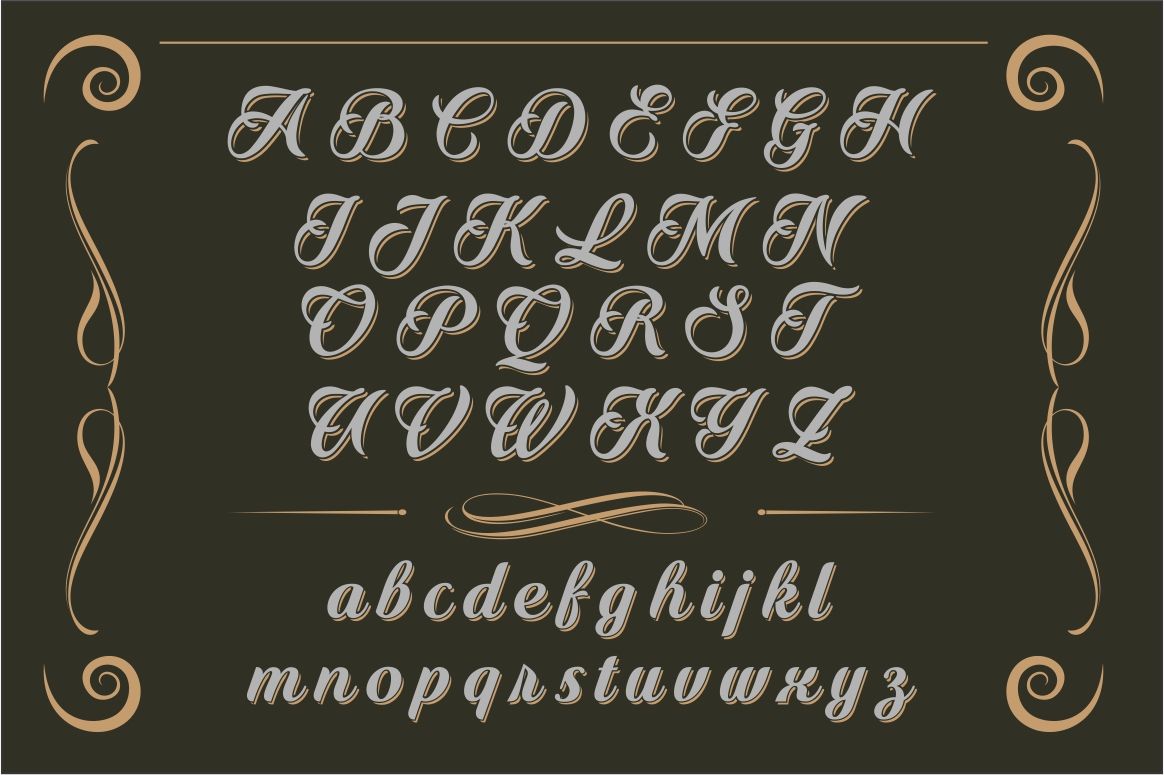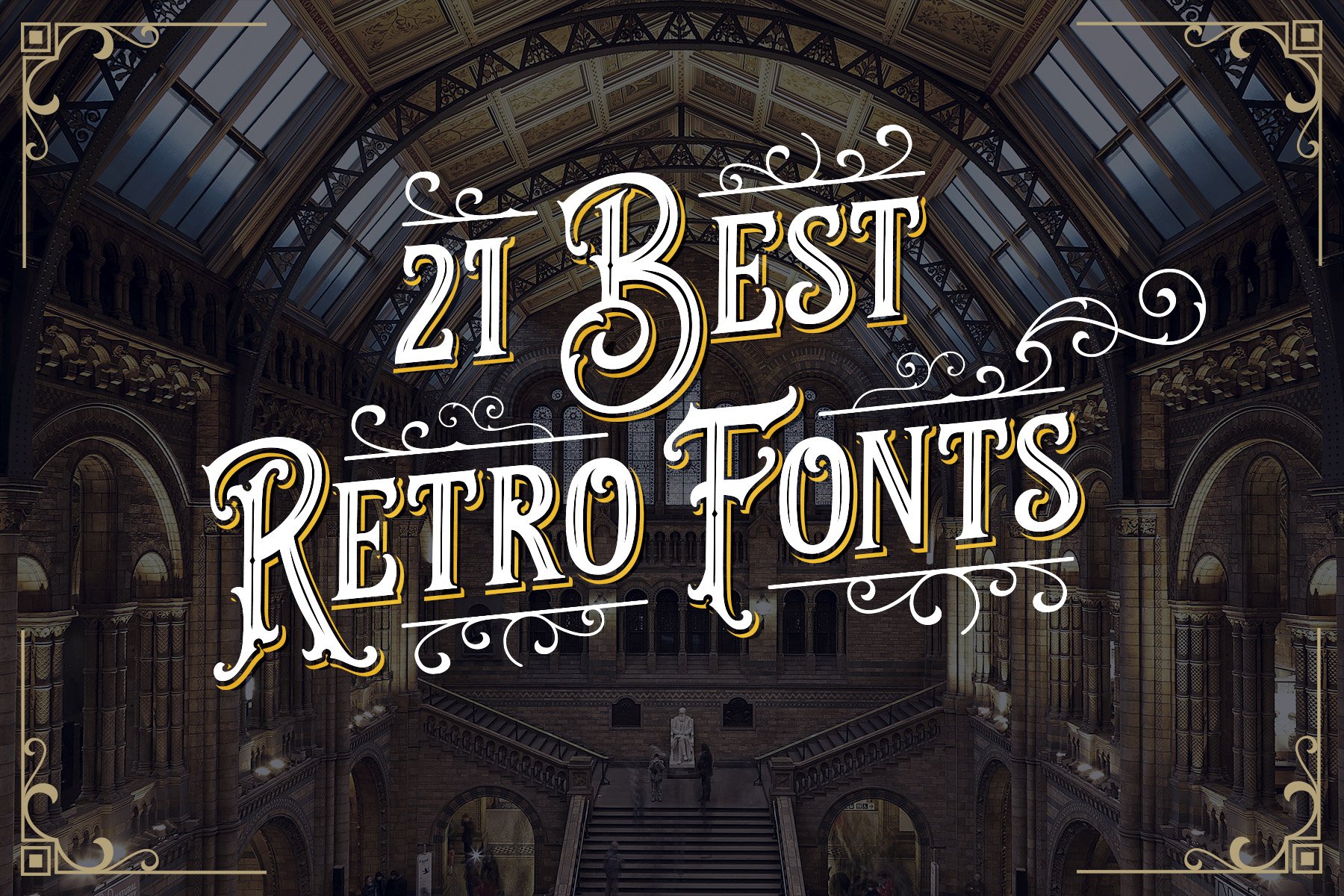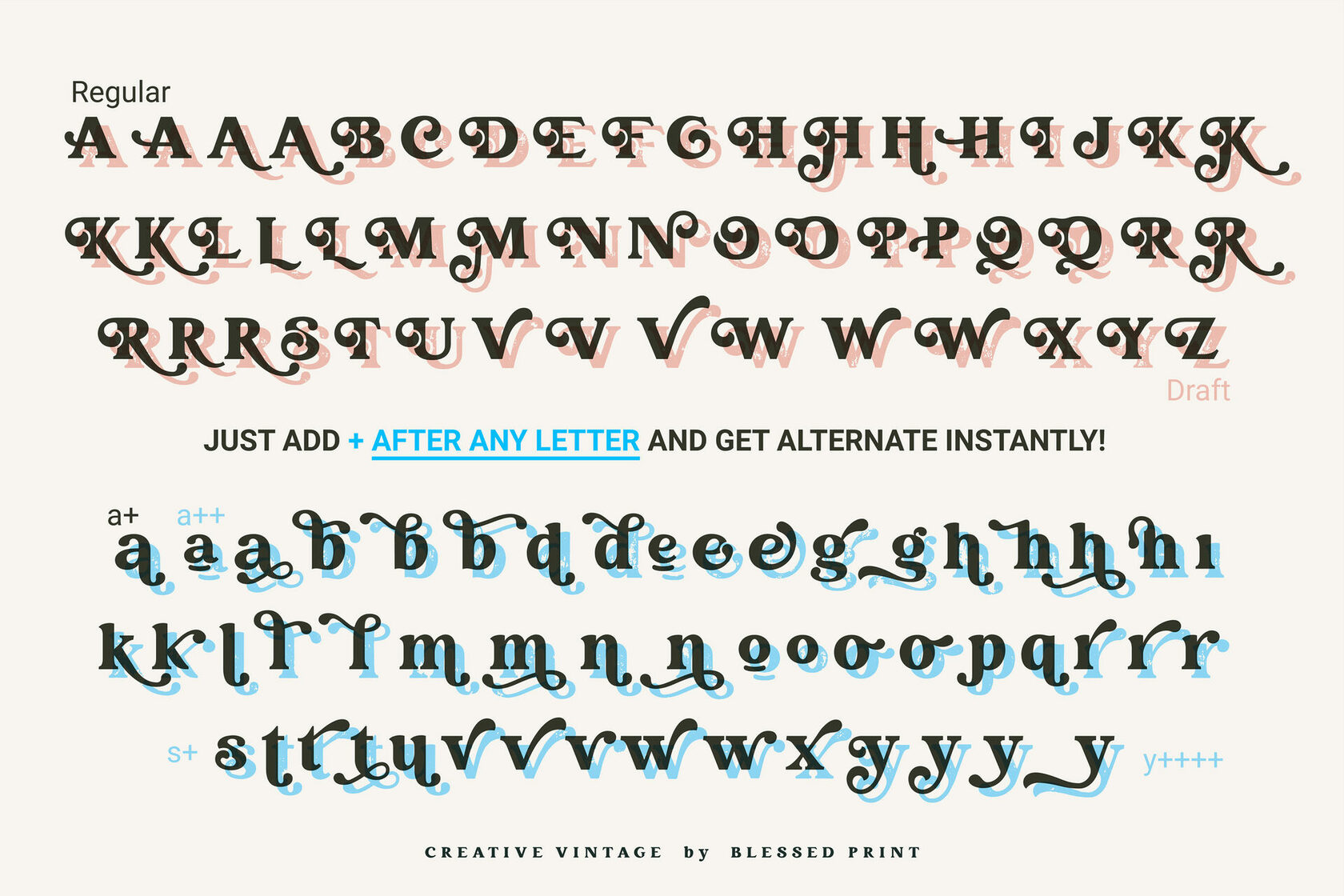Creative vintage fonts, with their timeless charm and nostalgic appeal, have captivated designers and enthusiasts alike. Their intricate details and evocative character bring a touch of history and authenticity to any project. From branding and packaging to web design, these fonts add a layer of depth and intrigue that sets them apart from their contemporary counterparts.
In this comprehensive guide, we’ll delve into the world of creative vintage fonts, exploring their origins, design principles, and applications. We’ll uncover the techniques used to create these captivating fonts, discuss their impact on branding and design, and showcase inspiring examples that demonstrate their versatility and timeless appeal.
Introduction to Creative Vintage Fonts

Vintage fonts have a timeless appeal that evokes nostalgia and adds a touch of elegance to any design. Originating from the early days of printing and typography, these fonts often feature intricate details, decorative flourishes, and unique letterforms that reflect the styles of past eras.Their aesthetic charm lies in their ability to convey a sense of history, tradition, and craftsmanship.
Notable examples include Bodoni, Caslon, and Didot, which have been widely used in classic literature, branding, and packaging design.
Historical Influences on Creative Vintage Fonts

The evolution of creative vintage fonts is deeply rooted in historical periods and art movements. These influences have shaped the aesthetics, forms, and styles of fonts, giving them a unique and nostalgic charm.
Typography and Calligraphy
Typography, the art of arranging type, and calligraphy, the art of beautiful handwriting, have significantly influenced vintage fonts. Early fonts were inspired by the elegant and intricate scripts used in medieval manuscripts and Renaissance books. As printing technology advanced, these scripts evolved into more legible and standardized typefaces.
Art Nouveau and Art Deco
The late 19th and early 20th centuries witnessed the rise of Art Nouveau and Art Deco, which had a profound impact on font design. Art Nouveau fonts are characterized by flowing, organic lines and decorative elements, while Art Deco fonts are known for their geometric shapes, bold lines, and streamlined appearance.
Mid-Century Modern
The post-World War II era saw the emergence of Mid-Century Modern design, which influenced fonts with its clean lines, geometric forms, and retro aesthetics. Fonts like Helvetica and Futura epitomize this style, embodying the sleek and functional spirit of the time.
Psychedelic and Hippie Culture
The 1960s and 1970s brought about psychedelic and hippie culture, which left a lasting mark on font design. Psychedelic fonts are characterized by vibrant colors, distorted shapes, and a sense of movement, while hippie fonts embrace peace and love themes with groovy and handwritten styles.
Conclusion
Historical periods and art movements have played a crucial role in shaping the development of creative vintage fonts. From the elegant scripts of the Renaissance to the bold geometric forms of Art Deco, these influences have given vintage fonts their timeless appeal and enduring popularity in contemporary design.
Explain the fundamental design principles involved in creating creative vintage fonts.

Vintage fonts evoke a sense of nostalgia and authenticity, capturing the essence of bygone eras. Crafting these fonts requires an understanding of fundamental design principles that govern their unique aesthetic.
Key principles include:
- Letterform Construction:Vintage fonts often feature distinctive letterforms with exaggerated serifs, decorative swashes, and intricate flourishes.
- Spacing:Careful attention to spacing between letters, words, and lines creates a balanced and visually pleasing composition.
- Ornamentation:Ornate embellishments, such as flourishes, swashes, and drop caps, add character and visual interest to vintage fonts.
Techniques for Creating Creative Vintage Fonts
The creation of captivating vintage fonts entails employing diverse techniques. These methods empower designers to produce fonts that exude the charm and nostalgia of bygone eras.
Among the most prevalent techniques is digital illustration, which involves using software to meticulously craft each character. This method grants designers precise control over every aspect of the font’s appearance, from the curves and flourishes to the overall shape and texture.
Hand-Lettering
Hand-lettering, an art form in its own right, involves the manual creation of characters using a pen, brush, or other writing instrument. This technique imparts a unique, personal touch to fonts, as each character is imbued with the artist’s individual style and flair.
Font Editing Software
Font editing software provides designers with a powerful toolset for modifying and refining existing fonts. These programs enable designers to adjust letterforms, add decorative elements, and experiment with various effects to create truly bespoke fonts.
Creative Vintage Fonts in Design
Creative vintage fonts add a touch of nostalgia and charm to various design applications. Their unique aesthetic evokes a sense of history and authenticity, making them popular for projects seeking a vintage or retro feel.
In branding, vintage fonts create a distinct and memorable brand identity. For example, the iconic Coca-Cola logo features a flowing script font that evokes a sense of tradition and quality.
Packaging
On packaging, vintage fonts enhance the product’s perceived value and appeal. They convey a sense of authenticity and craftsmanship, making them suitable for premium or artisanal products.
Web Design, Creative vintage font
In web design, vintage fonts can create a unique and engaging user experience. They add visual interest and can help establish a brand’s personality. For example, a website featuring a vintage-inspired font may evoke a sense of nostalgia or whimsy.
Pairing Creative Vintage Fonts with Other Elements

Pairing creative vintage fonts with other design elements is crucial for achieving a cohesive and visually appealing design. Consider the following factors:
Color Schemes:Choose color schemes that complement the vintage aesthetic. Warm and earthy tones, such as browns, greens, and reds, can evoke a sense of nostalgia. Muted and pastel colors, like soft blues and pinks, add a touch of elegance.
Textures
- Aged Textures:Incorporate textures that mimic aged paper, parchment, or fabric. This adds depth and character to the design, enhancing the vintage feel.
- Natural Textures:Use textures inspired by nature, such as wood grain or stone. These textures add a rustic and organic element, grounding the design in a timeless aesthetic.
Imagery
Select imagery that aligns with the vintage theme. Consider using vintage photographs, illustrations, or retro-inspired graphics. Ensure the imagery complements the font style and overall design aesthetic.
Experiment with a creative vintage font to give your designs a touch of nostalgia. If you’re looking for inspiration, check out the creative galaxy cast. It’s a collection of stylish and versatile fonts that will add a unique flair to your projects.
From elegant serifs to playful scripts, the creative vintage font options are endless. Embrace the past and give your designs a timeless appeal with a creative vintage font.
Customization of Creative Vintage Fonts

Customizing creative vintage fonts allows designers to tailor them to specific design needs, enhancing their versatility and impact. By altering letterforms, adding ornamentation, and creating unique ligatures, designers can create bespoke fonts that align seamlessly with their design vision.
Altering Letterforms
- Adjust the shape, size, and proportions of individual letters to create unique and eye-catching variations.
- Experiment with letter spacing, kerning, and tracking to control the overall rhythm and flow of the font.
- Consider adding or removing serifs, modifying stroke thickness, and experimenting with different letter heights to create distinct styles.
Adding Ornamentation
- Incorporate decorative elements such as flourishes, swashes, and drop caps to add a touch of elegance and vintage charm.
- Add subtle textures or patterns to the letterforms to create a sense of depth and visual interest.
- Experiment with different colors and gradients to enhance the visual appeal of the font.
Creating Unique Ligatures
- Design custom ligatures to connect specific letter combinations seamlessly, improving readability and adding a touch of sophistication.
- Create ligatures that reflect the overall style and tone of the font, enhancing its cohesiveness.
- Consider using ligatures sparingly to avoid overwhelming the design and maintain visual clarity.
– Discuss the use of creative vintage fonts in different industries, providing examples of their application in fashion, entertainment, and hospitality.

Vintage fonts exude an aura of nostalgia, authenticity, and timeless appeal, making them highly sought after in various industries. In fashion, entertainment, and hospitality, these fonts play a crucial role in shaping brand identity and creating a distinct aesthetic.
Fashion
In the fashion industry, vintage fonts evoke a sense of heritage and luxury. Brands like Burberry and Gucci incorporate vintage fonts into their logos and marketing materials to convey a sense of timeless elegance. For instance, Burberry’s iconic “Burberry” logo features a vintage serif font that reflects the brand’s long-standing tradition in British fashion.
Entertainment
In the entertainment industry, vintage fonts are often used to create a sense of nostalgia and evoke memories of a bygone era. Film studios like Warner Bros. and Disney employ vintage fonts in their movie posters and promotional materials to transport audiences back in time.
For example, the “Batman” movie franchise has consistently used a vintage art deco font in its logos and posters, which adds to the film’s retro appeal.
Hospitality
In the hospitality industry, vintage fonts contribute to the creation of a cozy and inviting atmosphere. Hotels and restaurants use vintage fonts in their signage, menus, and décor to evoke a sense of warmth and familiarity. For instance, the Waldorf Astoria hotel in New York City features a vintage script font in its logo, which complements the hotel’s opulent and historic ambiance.
– Identify current trends in creative vintage font design.
Current trends in creative vintage font design encompass a fusion of retro aesthetics with contemporary design sensibilities. Designers are experimenting with nostalgic elements, such as distressed textures, retro-inspired letterforms, and vintage-style embellishments, while incorporating modern techniques and digital tools to create unique and visually appealing fonts.
Emerging Styles
- Art Deco Revival:Geometric shapes, bold lines, and opulent ornamentation reminiscent of the 1920s and 1930s are making a comeback.
- Nostalgic Nostalgia:Fonts that evoke memories of childhood, old movies, and classic literature are gaining popularity.
- Retrofuturism:A blend of vintage aesthetics with futuristic elements, creating fonts that are both nostalgic and forward-looking.
Inspiration and Resources for Creative Vintage Fonts
Inspiration for creative vintage fonts can be found all around us, from antique books and magazines to vintage signage and packaging. There are also a number of online resources and design communities that can provide inspiration and support.
Online Resources
- Google Fonts: Google Fonts offers a large collection of free vintage fonts that can be used for both personal and commercial projects.
- DaFont: DaFont is a popular website that hosts a vast collection of free and premium vintage fonts.
- FontSquirrel: FontSquirrel offers a curated selection of high-quality vintage fonts that are free to download and use.
Books
- The Big Book of Vintage Fontsby Jim Krause and Steven Heller
- Vintage Type: A Field Guide to Identifying and Using Historic Typefacesby Steven Heller and Louise Fili
- The Type Specimen Book: A Compendium of Typefaces from the 19th Century to the Presentby Fred Smeijers
Design Communities
- Typekit: Typekit is a subscription-based service that provides access to a large library of fonts, including a number of vintage fonts.
- Adobe Typekit: Adobe Typekit is a subscription-based service that provides access to a large library of fonts, including a number of vintage fonts.
- Creative Market: Creative Market is a marketplace where you can buy and sell digital products, including fonts.
Creating a Vintage Font Portfolio

Creating a portfolio of your creative vintage fonts is crucial for showcasing your skills and attracting potential clients. It serves as a visual representation of your talent and the range of your work.
When selecting fonts for your portfolio, consider their versatility, originality, and appeal to your target audience. Choose fonts that demonstrate your understanding of vintage design principles and your ability to create unique and captivating typefaces.
Showcasing Your Fonts Effectively
- Use high-quality mockups to display your fonts in realistic applications, such as on posters, packaging, or websites.
- Create a dedicated website or online portfolio where potential clients can easily browse and download your fonts.
- Use social media platforms to share your fonts and connect with potential clients who are interested in vintage design.
Marketing Your Fonts
- Reach out to design agencies, branding firms, and other businesses that may be interested in using your fonts.
- Submit your fonts to online font marketplaces and directories to increase their visibility.
- Offer free trials or demos of your fonts to potential clients to give them a taste of your work before they commit to a purchase.
Future of Creative Vintage Fonts

The future of creative vintage fonts in the design industry looks promising. As technology advances and design trends evolve, we can expect to see new and innovative ways to use these fonts.
Potential Advancements in Technology
One area of advancement is in the development of artificial intelligence (AI) and machine learning (ML) algorithms. These technologies can be used to automate the process of creating vintage fonts, making it faster and easier for designers to create unique and customized fonts.
Evolving Design Trends
Another area of evolution is in the way that vintage fonts are used in design. In recent years, there has been a growing trend towards using vintage fonts in modern and contemporary designs. This trend is likely to continue, as designers seek to create designs that are both stylish and timeless.
Case Studies of Creative Vintage Fonts in Design

Creative vintage fonts have found widespread application in various design projects, contributing to their success and enhancing the overall design impact. Here are some case studies that showcase the effective use of vintage fonts:
In the fashion industry, the use of vintage fonts has been instrumental in creating a nostalgic and timeless appeal. For example, the luxury brand Gucci employed the vintage font “Didot” in its marketing campaign, evoking a sense of elegance and sophistication.
The font’s sharp serifs and delicate curves complemented the brand’s high-end aesthetic, resonating with its target audience of fashion-forward consumers.
Entertainment Industry
The entertainment industry has also embraced the charm of vintage fonts. In the movie poster for the Academy Award-winning film “The Shape of Water,” the title was rendered in the vintage font “Bodoni.” The font’s bold and assertive strokes captured the film’s themes of love, loss, and the power of difference.
It effectively conveyed the movie’s unique blend of romance and fantasy, attracting a wide audience.
Hospitality Industry
The hospitality industry has recognized the ability of vintage fonts to evoke a sense of nostalgia and comfort. The boutique hotel “The Ace Hotel” in New York City uses the vintage font “Cooper Black” throughout its branding. The font’s playful and retro style reflects the hotel’s eclectic and vibrant atmosphere, appealing to a target audience of travelers seeking a unique and memorable experience.
Challenges and Best Practices
While vintage fonts offer a wealth of design possibilities, their use in contemporary design presents certain challenges. One challenge lies in balancing the vintage aesthetic with modern design trends. Designers must carefully consider the overall design context to ensure that the vintage font complements the other design elements and does not appear out of place.
To successfully incorporate vintage fonts into contemporary design, best practices include choosing fonts that are legible and visually appealing in both digital and print formats. Additionally, designers should consider the cultural and historical associations of the font to ensure that it aligns with the intended message and target audience.
FAQ Overview
What are the key characteristics of creative vintage fonts?
Creative vintage fonts often feature intricate details, such as flourishes, swashes, and ornaments, that give them a timeless and sophisticated look. They may draw inspiration from historical periods or art movements, such as Art Deco, Victorian, or Gothic, and often evoke a sense of nostalgia and authenticity.
How can I incorporate creative vintage fonts into my designs?
When incorporating creative vintage fonts into your designs, consider their overall style and the message you want to convey. Pair them with complementary colors and textures to create a cohesive and visually appealing aesthetic. Use them sparingly as accents or headlines to avoid overwhelming your design.
Where can I find inspiration for creative vintage fonts?
There are numerous online resources and design communities where you can find inspiration for creative vintage fonts. Explore websites such as Creative Market, Font Squirrel, and Google Fonts, or browse through design portfolios and magazines to discover unique and captivating fonts.